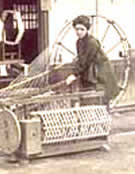
|
|
|
page
2
|
selected information |
|
The story of Knitting in Japan, Part 2 |
|||||
| Izo Matukawa | |||||
|
Izo Matukawa was the protege of two well known missionaries in Osaka, a British woman called Jane Caspari and the Reverend Paulo. Jane Caspari arrived in Japan around 1882 after a spell as principle of the Annie Walsh memorial School in Sierra Leonne. She seems to have had almost as much fervour for her knitting as she did her religion. Using up her own precious stocks of English yarn, she taught knitting to her Japanese Christian converts, one of whom was Izo Matukawa. He was inspired by her to devote his life to promoting the craft of knitting. He learnt very rapidly, also studying dyeing techniques with the Reverend Paulo. To some extent the beginnings of the Japanese method of making hand knitting patterns with charts can be traced all the way back to him. It was he who first thought of the idea of adapting knitting patterns along the lines of the markings used on canvas embroidery patterns. In 1885, with support from missionary Gaspary he organised workshops to spread his new techniques at Shimanouchi church, Osaka. Perhaps these were the first ever knitting workshops run by a Japanese. In 1886 Mr Matukawa published his own handbook, entitled 'Step by Step Knitting Patterns'. Jane Caspari died in 1888 and was buried at the foreigners cemetery in Kobe. |
|||||
|
Yarn Supplies Ms Caspari's dwindling stocks of yarn were to have momentous repercussions. She arranged for an Osaka merchant called Harra to import yarns directly from the United Kingdom. Later, still desperate to secure the supplies she needed, she and the Reverend Paulo encouraged a another Osaka merchant, Toyosuke Yoshikawa, to become importer of knitting yarns as well. He imported knitting and weaving yarns from Germany, France, the USA and the UK, in the process helping Osaka to become the centre of the yarn merchandising business all the way to the Second World War. |
Cottage Industry & Leisure Activity Knowledge of hand knitting had spread beyond the small number of missionary school converts, and was being taught privately by retired teachers and well educated widows. Hand knitted woollen shawls, mittens and gloves, socks, bibs - had all started to appear in stores from around 1890. Hand knitting was developing into a large cottage industry. This had in part been promoted by the Japanese Ministry of Education which published 2 of the first Japanese knitting manuals (or 'kniching' , as it was written there), entitled 'Dojosen', between 1877 and 1879. Between 1889 and 1910 there were more publications, mostly aimed at women, with titles such as 'Introduction to Wool Knitting' (1889), 'Essential Women's Handicrafts' (1904), 'Knitting Schoolbook' (1907). Western manners, clothing and leisure pursuits had become highly fashionable amongst well-to-do Japanese society, and hand knitting, being one of those things that western women did, was adopted in the same spirit. The crafts leisure industry that companies such as Nihon Vogue would eventually help create during the second half of the Twentieth Century has its roots in these years. |
||||
|
A woman in the Meiji period winding
silk
|
 |
The Japanese Textile Industry The Meiji government had identified textiles as one of the key industries targeted for rapid industrialisation, and by 1913 textiles would make up 45% of Japanese industrial output and employ 60% of the workforce. The government created state run model factories to demonstrate the principals of mass production. The workforce was drawn from the daughters of the samurai class. Almost none of these government factories were financially successful, but they did point the way. In 1879 one such factory produced Japan's first industrially woven woollen cloth (silk products dominated textile output at this point in time) and by the following year private industry was following suite with the founding of the Wool Spinners Company of 1880 and the Woollen Woven Textile Company of 1881. Many more textile factories were established throughout the 1890's |
|||
|
War between China and Japan (the Nishin War of 1894-1895)
provided these early textile factories with a steady supply of orders
for military clothing and fabrics. Industrial knitting was also developing
rapidly, supplanting the cottage industry of hand knitting , so that by
the beginning of the second half of the Meiji period ( 1903-1907) 70-80%
of knitted goods in the shops were produced by Japanese industrial knitting
companies.
|
|||||
| >> page 3 | |||||